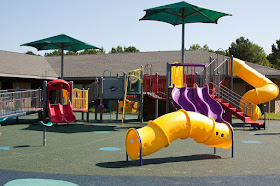Onlooker Play: What it Is and Why it Matters!
Onlooker play can look a little concerning at first. I'm sure we've all looked at children playing and seen one child standing on the sidelines, just watching. You might wonder why that child doesn't join in: Are they shy? Are the other kids being mean to them? But sometimes, there's nothing at all to worry about.
Onlooker play is a completely normal type of play, one of several stages that young children move through. It's a particularly important stage because it's the first time children express interest in the play of other children. During this stage, children watch other children at play. If it's your child doing the watching, your first instinct will probably be to encourage them to engage with other kids. After all, you want them to be able to have fun on the playground equipment like the other kids. But fight the urge to intervene. The truth is that this stage is part of how kids learn to play with others, and if you interfere with onlooker play, you'll be interrupting your child's healthy development. This is part of how they learn about social interactions, how other children manipulate playthings, and what playing with other children looks like.
The Six Stages of Play
Mildred Parten, a researcher at the University of Minnesota's Institute of Child Development, identified six stages of play that children experience developmentally. Remember that each child develops at their own speed: Two children of the same age might be at different stages, so don't fret if your neighbor's kid is engaging in associative play while yours is still in the onlooker stage. The six stages are:
- Unoccupied Play: Babies and young children are reasonably still in their movements, and their play looks scattered. They mostly focus on exploring materials available to them and practice manipulating the materials.
- Solitary Play: Children play alone. This sometimes worries parents, but it shouldn't! Children at this stage are mastering new motor and cognitive skills and exploring the idea of play.
- Onlooker Play: Children watch other children playing without joining in. This gives children a chance to learn about peer interactions and how other children manipulate play materials.
- Parallel Play: Children play adjacent to each other but don't actually interact with each other. They may occasionally look at the other child or children and copy what they are doing.
- Associative Play: This is the stage of play when children start expressing interest in interacting with each other. They put into action what they observed during onlooker and parallel play and start practicing their social skills.
- Cooperative Play: At this stage, children make group goals for play, establish rules, and work through conflicts.
Support Your Child in Onlooker Play
How can you support your young children during all stages of play development, especially during onlooker play? It's simple. First, provide ample opportunities for play: Take them to the playground, bring them on a nature walk, set out some art supplies for them to use, or just shoo them out into the backyard for a while. Then, try not to interfere: Let them find their own way to play. Children in control of their own play learn to follow their own interests and make appropriate choices. If they want you to help them climb the jungle gym or play pretend with them, they'll ask.
Find more about the author: Kim Hart











































